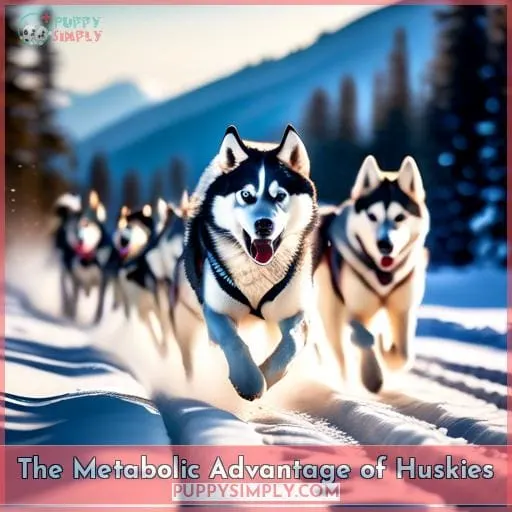This site is supported by our readers. We may earn a commission, at no cost to you, if you purchase through links.
 You crave glimpsing into how far your energetic Husky could go.
You crave glimpsing into how far your energetic Husky could go.
Science says their limits know no bounds if you train right.
Awaken their inner wolf to run long by:
- Starting slow
- Mastering form
- Building gradually
Together, tap into the freedom these working dogs thirst for through movement outdoors.
Feel belonging as you bond over chasing horizons.
Table Of Contents
- Key Takeaways
- Husky’s Running Capabilities
- Husky Energy and Endurance
- Huskies in Sled Dog Races
- The Metabolic Advantage of Huskies
- Historical Contributions of Huskies
- Conditioning Your Dog for Long-Distance Running
- Safety and Supplements for Long-Distance Running Dogs
- Frequently Asked Questions (FAQs)
- How do huskies compare to other dog breeds in terms of intelligence and trainability for long-distance running?
- What are the common health issues that huskies face as they age, especially those that have been active runners?
- How does the diet of a long-distance running husky differ from that of a typical household pet husky?
- Can huskies adapt to running on different terrains, such as sandy beaches or rocky trails, and what precautions should be taken?
- What are the psychological benefits of long-distance running for huskies, and how does it affect their behavior and happiness?
- Conclusion
Key Takeaways
- Huskies are renowned for their exceptional running capabilities, with average huskies capable of running 10-20 miles per session, trained huskies up to 40 miles at a time, and sled huskies over 100 miles per day. The world record for a husky is 1,000 miles in 8 days, demonstrating their remarkable endurance with proper conditioning.
- Huskies possess high stamina and endurance compared to average dogs and are comfortable running upwards of 40 miles in a single session. They were originally developed for long-distance sled pulling and have a metabolic advantage that allows them to shift to fat-burning for energy, along with a higher mitochondrial density for fat utilization.
- Training a husky for long distances involves proper nutrition, access to water before, during, and after runs, paw protection on rough terrain, positive reinforcement for long-distance running, and a gradual increase in mileage by 10% weekly.
- Huskies have historically excelled in sled dog races, competing in sprint, mid-distance, and long-distance races, and outperforming other breeds in endurance and resilience. They have also made significant historical contributions, such as the 1925 serum run to Nome, Alaska, where they delivered diphtheria antitoxin across 674 miles in 5.5 days, demonstrating their remarkable endurance and resilience.
Husky’s Running Capabilities
While the average husky can run 10-20 miles per session, trained huskies are capable of much more impressive distances – up to 40 miles at a time.
Sled huskies in particular can travel over 100 miles per day, with the world record for longest distance covered being 1,000 miles in just 8 days.
Clearly, huskies have remarkable endurance capabilities when properly conditioned.
Average, Trained, and Sled Husky Distances
Between you and me, the distances huskies can run really depend on their level of training.
Average huskies go 10-20 miles per session.
Trained huskies can handle up to 40 miles at a time.
Sled huskies can traverse over 100 miles per day in races.
Average pet huskies comfortably run 10-20 miles when properly conditioned.
With optimal training methods focused on canine endurance, huskies can reach upwards of 40 miles in a single run.
Sled huskies racing in events like the Iditarod demonstrate the immense stamina of the breed, covering over 100 miles daily while pulling a sled.
Proper conditioning and preparation are key to unleashing a husky’s innate mental and physical endurance capabilities.
World Record Husky Runs
Five huskies set the world record by running 1,000 miles from Nenana to Nome, Alaska in 8 days back in 2008.
These record-breaking canines demonstrated extreme endurance, racing husky feats, and marathon paws over long-distance running.
With speed demon energy, the huskies unleashed stamina comparable to Iditarod trail racers.
Their accomplishment stands as a testament to racing huskies’ capabilities, showcasing the breed’s phenomenal speed and endurance when harnessed for competition.
Though few husky teams could replicate this feat, it revealed their astounding athletic potential when driven to push the limits.
Husky Energy and Endurance
When compared to the average dog, a Siberian Husky has remarkable stamina and endurance capabilities.
With proper conditioning and training, Huskies can comfortably run upwards of 40 miles in a single session.
This high energy breed was originally developed to pull sleds long distances in frigid temperatures, giving them a natural athleticism and desire for activity.
Husky Vs Average Dog Endurance
With your husky’s high-energy temperament, you can promote activity and travel long distances while carrying loads that the average dog won’t handle.
Out-of-shape dogs are meant for 2-5 miles per day, but an in-shape husky is equipped for 40 miles of running daily with proper training.
Bred for their high stamina, huskies have a metabolic advantage compared to other breeds, allowing them to draw energy from fat stores and run up to 100 miles per day pulling loads during races like the Iditarod.
Tapping into your husky’s natural endurance takes strategic training approaches focused on gradually building distance, proper nutrition, and understanding their incredible athletic capabilities.
Training a Husky for Long Distances
You can train your husky to handle long distances like sled dogs.
Building their stamina starts with proper nutrition. High protein and fat kibble provides energy for runs.
Ensure access to water before, during, and after runs to prevent dehydration.
Booties protect paws from injury on rough terrain.
Condition their mind through positive reinforcement that running long distances is rewarding.
Invest time ramping mileage 10% weekly.
Joint supplements support bone health under heavy use.
With smart training, huskies unlock athletic endurance rivaling the Iditarod.
Huskies in Sled Dog Races
You’ll see huskies compete in sprint, mid-distance, and long-distance sled dog races.
They particularly excel in ultramarathon events like Alaska’s 1,100-mile Iditarod Trail Race, where they consistently outperform other breeds.
Huskies hold the 2017 Iditarod speed record: 8 days, 3 hours, 40 minutes.
Iditarod Trail Race Performance
The Iditarod Trail Race covers 1,100 grueling miles across Alaska.
Huskies routinely outperform other dog breeds by maintaining average speeds of around 137 miles per day over 8 days.
Huskies and their mushers employ strategies like pacing teams appropriately for trail conditions.
Mushers also utilize tactics like rotating dog teams to account for weather challenges on the Iditarod.
Despite the demanding race dynamics, huskies leverage their energy, endurance, and teamwork to excel, consistently beating out other breeds in this iconic Alaskan challenge.
Huskies Vs Other Breeds in Races
When pitting yourself against other breeds in races, you’ll find huskies consistently outpace competitors over long hauls.
Comparative speed
Stamina
Cold weather adaptations
Load pulling strength
Energy efficiency
Huskies thrive in the grueling conditions of long-distance sled dog races. Their endurance capabilities and resilience in frigid climates give them a competitive edge to outperform other breeds over multi-day hauls across snowy terrain.
Strategic pacing allows them to conserve energy while maintaining speed to eventually overwhelm the stamina of rival teams.
With the right conditioning, a team of huskies has the tools to conquer the toughest Arctic challenges.
The Metabolic Advantage of Huskies
As huskies run long distances, their muscle cells shift to extracting fat from the bloodstream for energy instead of glucose.
This metabolic switch allows them to tap into fat stores and run further without hitting the wall that human marathoners experience when glycogen is depleted.
Huskies also have a higher density of mitochondria than other breeds, which gives them an edge in utilizing fat for energy production.
Energy Sources During Long-Distance Running
Each husky utilizes unique energy sources outside their muscles to fuel their incredible endurance.
As glycogen stores deplete, huskies switch to burning fat. Their muscle cells extract fat from the bloodstream, allowing them to avoid muscle fatigue.
This gives huskies a tremendous metabolic capacity for long distances compared to other dogs.
While most dogs would overheat, huskies have adaptations like a thick coat and furry paws that allow heat dissipation, enabling them to keep running when other breeds would have to stop.
This fat-burning ability and innate heat tolerance let huskies run farther than nearly any dog.
High-Fat Diet and Mitochondrial Density
Huskies’ remarkable endurance is further enhanced by their high-fat diet and exceptional mitochondrial density, allowing them to efficiently convert fat into energy during long-distance runs.
Dietary fats are a key component of their endurance nutrition, providing a rich source of energy.
Their metabolic efficiency is a marvel of adaptation mechanisms, with cellular respiration in their muscle cells extracting fat from the bloodstream.
This unique ability, coupled with a higher mitochondrial density than other animals, enables Huskies to sustain their energy levels over vast distances.
Historical Contributions of Huskies
Huskies have made significant historical contributions, particularly in life-saving efforts.
A notable example is the 1925 serum run to Nome, Alaska, where a relay of 20 sled dog teams, led by huskies, delivered diphtheria antitoxin across 674 miles in 5.
Two huskies, Balto and Togo, emerged as heroes from this event, demonstrating the breed’s remarkable endurance and resilience.
The 1925 Nome Serum Run
You’ve seen how huskies can tap into their unique metabolic advantages for long-distance running.
But let’s take a moment to appreciate a historical event that truly showcased their remarkable endurance and resilience.
In 1925, a diphtheria outbreak threatened the remote town of Nome, Alaska.
Huskies played a crucial role in delivering life-saving serum to the affected area.
This epic Race of Mercy involved a relay of heroic huskies, demonstrating their incredible stamina and contribution to epidemic prevention.
Their life-saving relay is a testament to the husky’s extraordinary capabilities.
Famous Huskies: Balto and Togo
Having explored the incredible journey of the 1925 Nome Serum Run, we now turn our attention to two of its most celebrated heroes, Balto and Togo.
These remarkable huskies not only demonstrated the breed’s incredible stamina and resilience but also left a lasting legacy through their historical contributions.
Balto, often remembered for the final leg of the relay, became a symbol of hope and bravery, immortalized with a statue in New York’s Central Park.
However, it’s important to recognize that Togo, under the guidance of musher Leonhard Seppala, covered the longest and most perilous part of the journey, showcasing extraordinary leadership and endurance.
Despite Balto receiving much of the initial glory, Togo’s critical role has gained recognition over time, highlighting the teamwork and collective effort of all involved in this life-saving mission.
Conditioning Your Dog for Long-Distance Running
When conditioning your Husky for long-distance running, it’s crucial to increase their mileage gradually.
Aim for about a 10% boost each week.
This mirrors human athletic training and helps prevent injuries by allowing your dog’s body to adapt to the increased demands.
Increasing Mileage Safely
Regularly, it’s crucial to increase your husky’s running distance in a safe and measured manner, just as you’d for yourself.
Embrace gradual progression, enhancing endurance without risking injury.
Implement hydration strategies to maintain peak performance, especially in varying weather conditions.
Recognize breed differences; huskies thrive in cold, yet may need extra care in heat.
Incorporate cross-training benefits to bolster overall fitness, ensuring your husky enjoys the freedom of the run and a sense of belonging in your shared athletic pursuits.
Rest and Recovery for Endurance Dogs
Just as you need rest days after intense workouts, your husky also requires downtime to recover and prevent injuries when training for long-distance running.
Muscle recovery is crucial; it allows tissues to repair and strengthen.
Hydration importance can’t be overstated, as it aids in recovery and maintains overall health.
Mental relaxation is also key, reducing stress and improving focus.
Sleep benefits include healing and energy restoration.
Lastly, nutrition optimization supports muscle repair and fuels future performance, rounding out a holistic approach to your husky’s endurance training.
Safety and Supplements for Long-Distance Running Dogs
When considering the safety and supplementation for your husky’s long-distance running, it’s crucial to prioritize their well-being.
Dehydration and heat exhaustion are significant risks, so ensure you provide ample water and monitor for signs of overheating, especially as huskies can struggle in temperatures above 60°F.
Paw pad injuries are also a concern; carrying protective booties and a first aid kit can help manage any issues that arise during your runs.
For their nutritional needs, supplements like joint support with glucosamine and chondroitin, and endurance-boosting whole food supplements can be beneficial.
Always consult with a veterinarian before starting any new supplement regimen for your husky.
Dehydration, Heat Exhaustion, and Paw Pad Injuries
While conditioning your husky for endurance is crucial, you’ll also need to vigilantly monitor for signs of dehydration, heat exhaustion, and paw pad injuries during long runs.
Hydration techniques are key, ensuring your husky has ample water access.
Paw protection, like dog booties, can prevent injuries.
Be alert for heatstroke symptoms, especially in warmer climates.
If injuries occur, prompt treatment is essential.
Lastly, endurance nutrition, including a high-fat diet, supports your husky’s energy needs, helping them go the distance safely and effectively.
Recommended Supplements for Endurance Dogs
To support your husky’s long-distance running capabilities:
- Consider integrating joint supplements containing glucosamine, chondroitin, MSM, and Hyaluronic Acid into their diet.
- These compounds aid in maintaining joint health and flexibility.
Nutritional needs of endurance dogs also include:
- Omega-3 fatty acids
- Anti-inflammatory compounds found in green-lipped mussel powder
Performance diets should be balanced with hydration strategies to maintain electrolyte balance.
Post-run, recovery nutrition is crucial.
Consult your vet before introducing any supplements, ensuring your husky’s health and peak performance.
Frequently Asked Questions (FAQs)
How do huskies compare to other dog breeds in terms of intelligence and trainability for long-distance running?
Huskies stand out for their exceptional endurance and adaptability in long-distance running, traits not as pronounced in many other breeds.
Their intelligence, particularly in problem-solving and adaptability, combined with their remarkable trainability for endurance tasks, sets them apart.
While they may require more repetitions to learn new commands, their ability to perform consistently in demanding physical activities like sled racing showcases a unique blend of physical and cognitive skills not universally found across dog breeds.
What are the common health issues that huskies face as they age, especially those that have been active runners?
Active huskies, especially those with a history of long-distance running, often face health issues as they age.
These issues include:
- Arthritis
- Hip dysplasia
- Eye problems such as cataracts and progressive retinal atrophy
They’re also at risk for hypothyroidism, which can affect their metabolism and overall energy levels.
To keep your husky healthy into their senior years, the following are crucial:
- Regular veterinary check-ups
- A balanced diet
- Appropriate exercise tailored to their age and health status
How does the diet of a long-distance running husky differ from that of a typical household pet husky?
The diet of a long-distance running husky differs significantly from that of a typical household pet husky.
Long-distance running huskies require a high-fat diet to support their energy needs and a metabolic switch during long-distance racing, allowing them to draw energy from sources outside their muscles.
Additionally, their muscle cells extract fat from the bloodstream for energy, and they have a higher mitochondrial density than other animals, which supports their endurance and resilience during long runs.
Can huskies adapt to running on different terrains, such as sandy beaches or rocky trails, and what precautions should be taken?
Just like Balto braved the Alaskan wilderness, your husky can adapt to various terrains, from sandy beaches to rocky trails.
However, remember that running on sand requires more effort, so monitor for overexertion.
Always ensure the terrain is safe, free from hazards like sharp objects or toxic plants. Keep them hydrated, watch for signs of fatigue, and avoid the hottest parts of the day to prevent overheating.
With these precautions, your husky can conquer any terrain, just like their sled-pulling ancestors.
What are the psychological benefits of long-distance running for huskies, and how does it affect their behavior and happiness?
Long-distance running boosts huskies’ mental well-being, reducing boredom and preventing behavioral issues.
It fulfills their innate need for activity, enhancing happiness and promoting a balanced temperament.
Conclusion
Crossing the finish line together, it’s clear that Huskies can indeed run long distances, tapping into a well of stamina that’s as deep as their ancestral roots.
By understanding their unique metabolic advantages and tailoring training to their needs, you’re not just a pet owner; you’re the guardian of a legacy.













